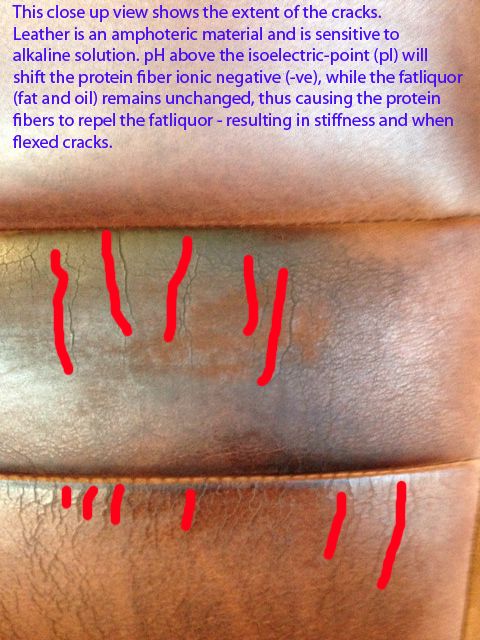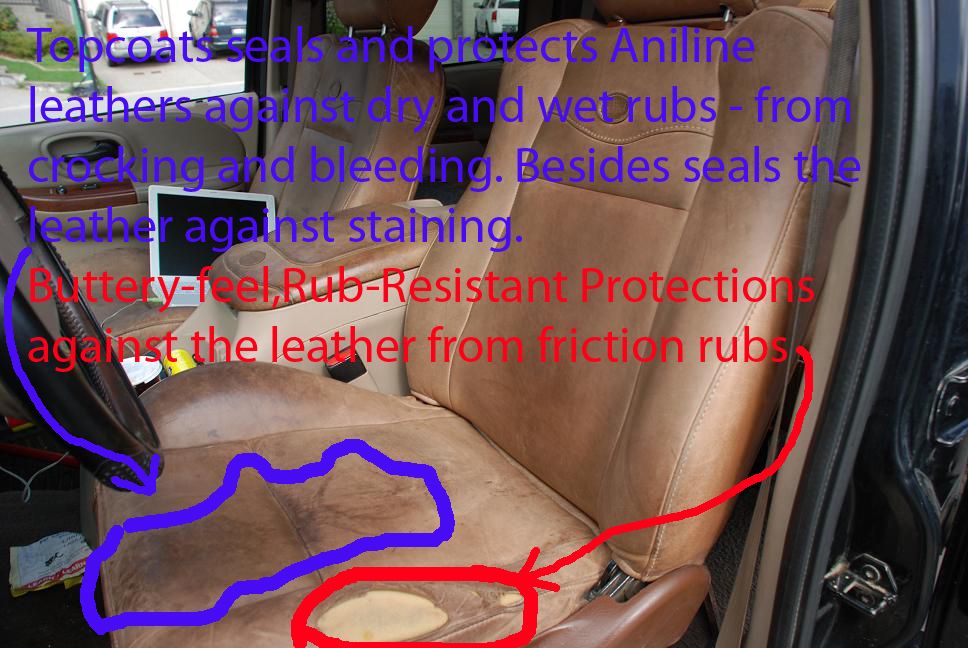Spoke with the fellow @ Leather Masters yesterday and I was told their `Leather Master Protection Cream` and if I dilute their Strong Leather Cleaner, I `d be good to go to clean and condition the seating on an F350 that`s got King Ranch Leather.
Yes/No, maybe so?
TIA -
Lance
Results 1 to 11 of 11
Thread: Y/A King Ranch Leather question
-
10-19-2012, 07:24 AM #1“Any man who can drive safely while kissing a pretty girl is simply not giving the kiss the attention it deserves.”
~Albert Einstein
-
10-24-2012, 06:16 AM #2
King Ranch, Chaparral or Castano (Ford F-Series) leather, it is important to understand that the seats were not intended to retain the pristine factory finish, they will weather and gain character beginning almost immediately, they are also subject to photo degeneration (fading) very quickly.
Remove surface dirt and dust, cleaning the seams periodically is important as dirt / grit will abrade the stitching causing them to fail, prise them apart, then use a soft brush, vacuum and then use a foam cleaner, one section at a time, and then finally wipe off with a clean, damp 100% cotton towel
The advantage of foam over liquid is the minimum amount of moisture, very important for cleaning absorbent and moisture sensitive leathers.
Use foam cleaner, which should be given dwell time and then gentle agitation with a medium stiff bristled brush to get the product into the materials surface, the low moisture content of foam can then be easily rinsed and the surface dried. Remove excess product and debris with a clean, damp 100% cotton micro fibre towel. If the foam is allowed to dry the soil will be re-deposited to the surface. Check the results and repeat process as necessary
For heavily soiled areas use a foam cleaner (Leather Master™ Foam Cleaner) that contains a surfactant that will lift dirt and soil, allow react time to do its work and then use a soft brush to agitate and loosen the dirt (Swissvax Leather Brush) especially on light coloured leathers; this enables the cleaning of the micro pores and creases and lifts the dirt out and reveal any further work that needs doing (dye transfer, stains, etc)
Wet a towel with warm water, wringing out excess. Proceed to wipe the leather to remove any dirt and moisten the surface. If you are working on a large item, do one section at a time so you can apply Leather Master™ Soft Touch (ex Vital) while the surface is still moist. This is not a conditioner per se but is used to improve and maintain the tactile feel and lustre by rehydration and to ensure the leather remains matte, soft and supple.
Apply a small amount to a clean, damp 100% cotton micro fibre towel, use a circular motion and slight pressure to ensure the product permeates the dried-out pores, but do not push hard enough to damage the leather. Allow 20-30 minutes dwell time and then wipe surface with a dry 100% cotton micro fibre towel. And then apply
Leather Master™ Protection (a Scotchgard™ type product specifically formulated for leather) the polymers penetrate the surface and cross-link to form a durable protective film that is breathable, allowing transpiration and keeps the leather supple.Being aqueous (water- based) it restores moisture and provides a protective sacrificial barrier against all kinds of soiling, water, oil, alcohol-based stains and perspiration marks, so you are cleaning the protective layer
Ultra violet (UV) protection 303® Aerospace Protectant will provide invaluable ultra violet (UV) protection against photo degradation (fading); especially in a roadster or convertible vehicle, steering wheel and dashboards.
Is water-based and will provide invaluable ultra violet (UV) radiation protection against photo degradation (fading) protection; especially in a roadster or convertible vehicles. It doesn’t contain silicones, so it won`t attract and capture dust. You should apply to a clean surface (it doesn’t contain any cleaning agents)
It will not prevent finished leather hydration (transpiration and evaporation of moisture) as it’s water-based, although it coats the leather with a micro fine coating; it will not seal it per se .
Associated Articles
1. “Reference sources and bibliography used for leather articles” - http://www.autopia.org/forum/autopia...ml#post1474865
2. “Leather Articles Hyperlinks” http://www.autopia.org/forum/autopia...yperlinks.html
What gets overlooked too often is that one must be a student before becoming a teacher.
-
11-09-2012, 05:16 PM #3
 Originally Posted by LeMarque
Originally Posted by LeMarque
Ford King Ranch leather, you see in this picture is aniline dyed, instead of the normal pigment coated leathers in other vehicles.
It is absorbent to a degree and when the clear topcoat wears off, the leather is more susceptible to liquid penetration including sweat.
What you see in these two pictures are leather creaking, most likely primary cause is sweat, secondary cause may be due to alkaline cleaning solution that compound the stiffening of the leather that when flex leads to cracks.
Remember that leather is an amphoteric material; the bulk of the protein fiber is, while the leather constituents like the tanning agents and the fatliquor are not.
When sweat or perspiration ferments, it starts to shift alkaline and so does affect the protein fiber from losing its ionic positive charge. Fat and oil that are hydrogen bonds with the protein fibers, slowly breaks its bonds and starts to leach out of the protein fiber resulting in stiffness that when flex leads to cracks.
This breaking of hydrogen bonds between the protein fiber and the fatliquors accentuated when “alkaline” cleaning solution is used to clean the sweat stains. In most cases after drying the leather is stiffer than before it was clean, this is a case where the alkaline solution boost up the pH higher, thus compounding the problem of the breaking of the hydrogen bond between the protein fiber and the fatliquor.
The reverse of the pH phenomenon is also true, by using an acidic solution below the average pH of 4 to charge the protein fiber and increase it positive (+ve) charge.
Sweat need to be neutralized with an acidic rinse around pH from 2 to 3.
These pictures show you the importance to used “leather-safe” system, before cracks sets in.
Preventive maintenance includes periodic replenishing of the fat and oil lost through evaporation and through leaching out from breaking of hydrogen bond between the amphoteric protein fibers and the fatliquor.
In situation, you see in these pictures, an acidic hydrator below the pI of leather is essential to relax and separates the stick together fiber.
When the leather structure is totally relax acidic fatliquor is replenished, so that when they are dry, softness and suppleness of the leather is return with tear- strength.
#1 Leather Cracking – possible primary cause is “Sweat”, secondary cause may be compounded with “Alkaline” solution.

#1 Close-up view of “Cracks”

Roger Koh
info@leatherdoctor.com
-
11-20-2012, 08:19 AM #4
Ooops ...
just got the notification of reply`s. Thanks for taking the time. Very informative info.“Any man who can drive safely while kissing a pretty girl is simply not giving the kiss the attention it deserves.”
~Albert Einstein
-
11-20-2012, 09:16 AM #5
I`ve found that skipping the cleaning step all together, I put an outrageous amount of treatment on the leather, then after a bit, add more, rub lightly with a soft brush - the treatment acts as an emulsifier - and wipe up the residue with a cloth is all I want to do. Sometimes I use my steamer from a distance away to break up the treatment as I remove it, but the steamer is back far enough it doesn`t get the leather hot or cause any water to run. Dry steam and your mileage will vary.
There are of course other times when I use cleaner and even a softened up magic eraser on leather, but in cases where I want to be very careful I use leather treatment the way cold cream is used to remove makeup. Sometimes I`m extremely risk averse.
Finally, I think if it was a really tricky situation, I`d wish Roger was handy.
Robert
-
11-20-2012, 12:20 PM #6
Roger, you stated in your post above that the KR leather`s "clear topcoat will wear off." I was under the impression that KR leather had no clearcoat topcoat. Can you comment?
-
11-20-2012, 02:45 PM #7
 Originally Posted by rexster314
Originally Posted by rexster314
Aniline dyed leathers without a topcoat would be poor in dry and wet rubs.
Topcoat primarily protects the dyestuff from crocking and bleeding, besides providing a barrier against staining.
See picture stain areas circle in blue
However, Buttery-feel Rub-resistant protection protects the topcoat from friction wears.
See picture wear-off areas with tear circle in red.

Roger Koh
info@leatherdoctor.com
-
11-20-2012, 05:10 PM #8
-
11-20-2012, 05:13 PM #9
[/QUOTE]Aniline dyed leathers without a topcoat would be poor in dry and wet rubs[/QUOTE]
Not so Roger - as long as the correct dyes are used these are locked into the leather and will be stable. We do a lot of colour restoration on Aniline leathers and use Aniline dyes with a fixing carrier which do not require a finish. A finish can be applied to make the leather finish more durable but it should always perform well under normal conditions. Some colour loss may be seen during cleaning processes but will be stable again once dry.
Clear coat finishes can suffer from cracking etc but a straight aniline dyed leather will not suffer from this. Specific Aniline cleaners are now available for this type of leather which do not contain surfactants so do not absorb into the leather like regular cleaners would so this enables more successful surface cleaning to take place. A good leather protector is crucial with thistle of leather to avoid staining etc.
Hope this helps
JudybLeather specialist
Instructor in leather cleaning, repair and restoration
-
11-20-2012, 08:20 PM #10
 Originally Posted by rexster314
Originally Posted by rexster314
Sorry, If I have not answer your question!
All aniline leathers will have a topcoat, you can show me some you think is without a topcoat.
I may learn from you!
Roger Koh
info@leatherdoctor.com
-
11-21-2012, 04:54 AM #11
Unprotected semi-aniline leather is rarely used for automobile upholstery; although Aniline is an immersion dye method not a leather type per se. Some super expensive exotics and luxury vehicles still use this type of leather. But due to its hard to care for nature it has been slowly phased out
Early model Ford F150 King Ranch leather upholstery used unfinished leather but later models switched to micro pigment (automotive-grade aniline) finished leather. This is the second most popular leather used in automotive upholstery, micro pigment is often protected by a micro-thin urethane, which is sometimes has pigmentation (colour) added, hence the name. It is important to understand that the seats were not intended to retain the pristine factory finish, they will weather and gain character beginning almost immediately; they are also subject to photo degeneration (fading) very quickly.What gets overlooked too often is that one must be a student before becoming a teacher.
Thread Information
Users Browsing this Thread
There are currently 1 users browsing this thread. (0 members and 1 guests)
Similar Threads
-
king ranch leather question.
By stotte20 in forum Car DetailingReplies: 24Last Post: 07-02-2011, 02:32 PM -
King Ranch Leather. What to use?
By musicawal in forum Auto Detailing 101Replies: 8Last Post: 08-28-2007, 09:25 PM -
King Ranch Leather
By Tex Star Detail in forum Auto Detailing 101Replies: 8Last Post: 02-27-2007, 10:39 AM -
King Ranch Leather
By ezd96 in forum Professional Detailer General DiscussionReplies: 4Last Post: 12-24-2006, 02:20 PM -
leather stuff on ford king ranch leather?
By imp-gmblack3 in forum Poorboy's World ForumReplies: 2Last Post: 07-06-2006, 02:51 PM






 Reply With Quote
Reply With Quote
Bookmarks